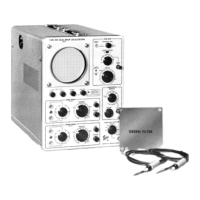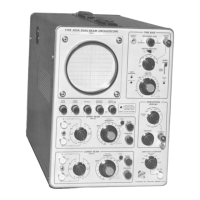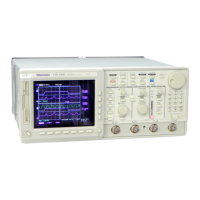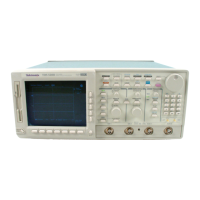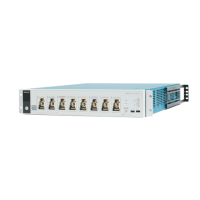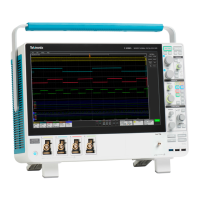Operating Instructions— Type 503
7. Set the VERTICAL SENSITIVITY control to the 1 mV/CM
position. Make sure that the SENSITIVITY VARIABLE con
trol has remained in the CALIBRATED position.
8. With the VERTICAL DC BAL. control, move the spot
back to where it was in step 6.
9. Set the HORIZONTAL SENSITIVITY control to the 1
mV/CM position. Make sure that the SENSITIVITY VARI
ABLE control has remained in the CALIBRATED position.
10. With the HORIZONTAL DC BAL. control, move the
spot back to where it was in step 6.
11. Adjust both DC BAL. controls so that the spot does
not move as the SENSITIVITY controls are moved from the
.2 VOLTS/CM position to the 1 mV/CM position.
The amplifiers in the oscilloscope are now balanced and
the oscilloscope is ready for operation as described in the
remainder of this section.
Graticule Illumination
Graticule illumination can be adjusted to the ambient
lighting conditions by means of the POWER AND SCALE
ILLUM. control. Turning the control counterclockwise (but
not to the PWR. OFF position) increases the graticule illu
mination. It is possible to extinguish the graticule illu
mination completely by turning the control fully clockwise.
The graticule of the Type 503 Oscilloscope can be illu
minated so that it appears to have either red or white
graticule markings. The markings can be changed from
white to red or red to white simply by removing the grati
cule cover and rotating the graticule. As a general rule,
white graticule lines are superior to red for photographic
purposes.
INPUT SELECTION
Two INPUT connectors and associated INPUT switches
are provided in each channel. When a single input signal
is used, it may be applied through either the +INPUT or
— INPUT connector. If the signal is connected to the
-pINPUT connector, the +INPUT switch should be placed in
either the AC or DC position, depending upon the type of
coupling desired. The —INPUT switch should be placed in
the GND position. If the signal is connected to the —INPUT
connector, the —INPUT switch should be placed in either
the AC or DC position, and + INPUT switch should be placed
in the GND position. It should be noted that when a signal
is applied to the —INPUT connector of either channel, the
display on the oscilloscope screen will be opposite in polar
ity to a normal presentation. Conventionally, a normal
display places the more positive portions of a waveform
in the vertical channel toward the top of the screen, and
the more positive portions of a waveform in the horizontal
channel toward the right-hand side of the screen.
When a display is desired which shows the difference
between two signals, the signals are connected to the two
INPUT connectors of the appropriate channel. In this case,
both INPUT switches are placed in either the AC or DC
position, depending on the type of input coupling desired.
In this mode of operation, (called the "differential" mode),
the two signals are added algebraically, and the difference
is displayed as a single trace on the screen. It permits elimi
nation of signals which are common to both inputs, and
observation of a waveform which is peculiar to one of the
signals. Figs. 2-4 and 2-5 show the effects of signal applica
tion to one or both INPUT connectors of the vertical channel.
The differential mode of operation also makes possible
the observation of current changes in a circuit. The changes
in the voltage drop across a given resistor are proportional
to the changes in current through it, so a differential dis
play of the voltages at the two ends of a resistor will show
the changes in current through the resistor.
Input Coupling
Input signals to both the vertical and horizontal chan
nels can be either AC or DC coupled by placing the cor
responding INPUT switches in the appropriate positions.
DC coupling applies both the AC and DC components of
the input signal to the amplifier circuits. This permits meas
urement of the DC voltage level as well as the amplitude
of the AC component. However, it is sometimes neither
necessary nor desirable to display the DC component, and
in such cases, AC coupling should be used. With AC cou
pling, a capacitor is placed in series with the INPUT con
nector to block the DC component while allowing the AC
component to be displayed.
2-4
Fig. 2-3. Line transformer wired fo r 117- and234-volt operation.
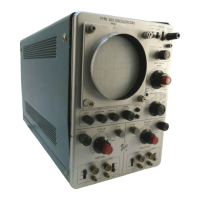
